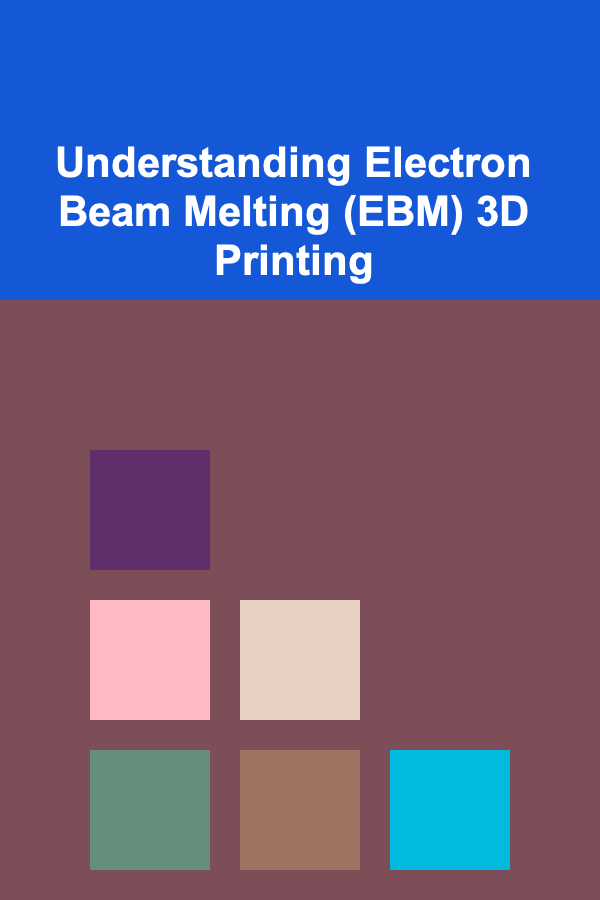
Understanding Electron Beam Melting (EBM) 3D Printing
ebook include PDF & Audio bundle (Micro Guide)
$12.99$10.99
Limited Time Offer! Order within the next:

Electron Beam Melting (EBM) is a powerful additive manufacturing (AM) technology that uses an electron beam to selectively melt and fuse metallic powders together, layer by layer, to create three-dimensional objects. It falls under the broader category of powder bed fusion (PBF) technologies, but distinguishes itself through its reliance on an electron beam and a vacuum environment. Understanding EBM requires delving into its unique process characteristics, advantages, disadvantages, material capabilities, and applications.
The EBM Process: A Step-by-Step Guide
The EBM process can be broken down into several key steps:
- Powder Bed Preparation: The process begins with a bed of metallic powder spread evenly across a build platform. This is typically achieved using a recoating system, which might involve a blade or roller that distributes a precisely controlled layer of powder. The thickness of this layer is a crucial parameter influencing the final part's resolution and mechanical properties. The powder is stored in hoppers, often heated to improve powder flow characteristics.
- Vacuum Environment: A critical characteristic of EBM is its operation within a high vacuum chamber. The vacuum, typically on the order of 10^-5^ to 10^-6^ mbar, serves several vital functions. It minimizes contamination of the molten metal by atmospheric gases like oxygen and nitrogen, which can lead to undesirable reactions and weakened mechanical properties. The vacuum also prevents scattering of the electron beam by air molecules, allowing for greater beam control and energy efficiency. Furthermore, the vacuum reduces the likelihood of electrical discharge.
- Electron Beam Generation and Control: The heart of the EBM system is the electron beam gun. This device generates a focused beam of high-energy electrons. The electrons are emitted from a heated filament (typically made of tungsten or tantalum) and accelerated through a high voltage potential difference (tens of kilovolts). Electromagnetic lenses are then used to precisely focus and steer the electron beam across the powder bed. This precise control is essential for selectively melting the powder particles according to the defined part geometry. The beam current and scan speed are also carefully controlled to manage the energy input and melt pool characteristics.
- Preheating and Sintering: Before the actual melting process begins, the powder bed is typically preheated using the electron beam. This preheating serves several important purposes. It sinters the powder particles together, improving the powder bed's thermal conductivity and preventing "smoking" or powder scattering during the melting process. Preheating also reduces thermal gradients within the part, which can minimize residual stresses and distortion. The preheating strategy can be complex, involving multiple passes of the electron beam with varying parameters.
- Melting and Solidification: The electron beam then selectively melts the powder in the areas defined by the part's cross-sectional geometry. The high energy of the electron beam causes the powder particles to fuse together, forming a solid layer. The melt pool, the small region of molten metal created by the beam, is carefully controlled to ensure complete fusion between the powder particles and proper bonding to the previous layer. The solidification process is rapid, leading to fine microstructures with potentially desirable mechanical properties.
- Layer-by-Layer Building: After one layer is completed, the build platform is lowered by a distance equal to the layer thickness, and a new layer of powder is deposited. The process of preheating, melting, and solidification is then repeated for the subsequent layer. This layer-by-layer process continues until the entire three-dimensional part is built.
- Cooling and Post-Processing: Once the build is complete, the part is allowed to cool down within the vacuum chamber. This cooling process is often slow and controlled to further minimize residual stresses. After cooling, the part is removed from the powder bed, and any loose powder is cleaned off. Post-processing steps, such as heat treatment, machining, or surface finishing, may be required to achieve the desired final properties and dimensions. The unsintered powder can be collected and reused, contributing to the economic viability of the process.
Advantages of EBM over Other 3D Printing Technologies
EBM offers several distinct advantages compared to other AM technologies, particularly those based on laser powder bed fusion (LPBF):
- High Energy Density: The electron beam provides a higher energy density compared to lasers used in LPBF. This allows for faster melting rates and the processing of materials with higher melting temperatures or higher reflectivity. It also contributes to deeper penetration into the powder bed, promoting stronger inter-layer bonding.
- Superior Material Properties: Due to the vacuum environment and the high energy density, EBM-produced parts often exhibit superior mechanical properties compared to parts made by other AM methods. The vacuum minimizes contamination, leading to higher purity and improved ductility. The high energy density promotes complete melting and fusion, resulting in denser parts with fewer internal defects. The preheating process further reduces residual stresses, contributing to improved fatigue resistance.
- Stress Relief During Build: The preheating process, unique to EBM, plays a significant role in reducing residual stresses during the build. The elevated temperature of the powder bed minimizes the temperature gradients between the newly solidified layers and the surrounding material, reducing the tendency for distortion and cracking. This is particularly advantageous for large or complex parts.
- Capability to Process Difficult-to-Weld Materials: EBM is particularly well-suited for processing materials that are difficult to weld using conventional methods, such as titanium alloys (Ti-6Al-4V, TiAl), nickel-based superalloys (Inconel), and refractory metals. The vacuum environment and precise control of the electron beam allow for the production of high-quality parts from these challenging materials.
- Good Material Utilization: The unsintered powder surrounding the built part can be collected and reused, leading to high material utilization rates. This is an important economic consideration, especially when dealing with expensive materials like titanium and nickel-based alloys. However, powder reuse requires careful management to maintain powder quality and prevent contamination.
Disadvantages and Limitations of EBM
Despite its advantages, EBM also has certain drawbacks and limitations:
- High Capital Investment: EBM machines are typically more expensive than LPBF machines due to the complexity of the electron beam gun and vacuum system. This high initial investment can be a barrier to entry for some companies.
- Slower Build Speeds Compared to Some LPBF Processes: While EBM boasts a high energy density, the overall build speeds can sometimes be slower than certain advanced LPBF processes, especially for parts with fine features. This is due to the need for preheating and the complexities of electron beam control.
- Limited Material Selection Compared to LPBF: While EBM excels with certain materials, the range of materials that can be successfully processed is currently more limited compared to LPBF. This is partly due to the need for materials with good electron conductivity and appropriate melting characteristics in a vacuum environment. Research is ongoing to expand the material selection for EBM.
- Rougher Surface Finish: EBM-produced parts typically have a rougher surface finish compared to parts made by LPBF. This is due to the larger powder particle size and the characteristics of the melting process. Additional post-processing steps, such as machining or surface finishing, are often required to achieve the desired surface finish.
- Chamber Size Limitations: The build volume of EBM machines is often limited by the size of the vacuum chamber. This can restrict the size of parts that can be produced.
- Vacuum System Maintenance: Maintaining the high vacuum environment requires specialized equipment and expertise. Vacuum pumps need regular maintenance, and leaks need to be promptly identified and repaired.
- Powder Handling Challenges: While powder reuse is an advantage, handling fine metal powders poses certain challenges. Powder needs to be stored and handled in a controlled environment to prevent contamination and ensure consistent quality. Appropriate safety measures are required to prevent inhalation or skin contact with the powder.
Materials Suitable for EBM
EBM is particularly well-suited for processing a range of metallic materials, including:
- Titanium Alloys: Ti-6Al-4V is the most widely used material in EBM. Its high strength-to-weight ratio, excellent corrosion resistance, and biocompatibility make it ideal for aerospace, medical implants, and other demanding applications. TiAl (titanium aluminide) is another titanium alloy used in EBM for high-temperature applications.
- Nickel-based Superalloys: Inconel 718 and Inconel 625 are commonly processed using EBM. These superalloys offer excellent high-temperature strength, creep resistance, and oxidation resistance, making them suitable for aerospace and energy applications, such as turbine blades and combustion chambers.
- Cobalt-Chrome Alloys: CoCrMo (cobalt-chromium-molybdenum) alloys are used in EBM for medical implants, particularly orthopedic implants, due to their biocompatibility and wear resistance.
- Stainless Steels: Certain stainless steels, such as 316L, can be processed using EBM, although they are more commonly processed using LPBF.
- Refractory Metals: EBM can be used to process refractory metals like tantalum and tungsten, which have extremely high melting points. These materials are used in specialized applications requiring high-temperature strength and resistance to erosion.
- Aluminum Alloys: While more challenging, research is ongoing to expand the use of EBM for aluminum alloys. The high reflectivity of aluminum to the electron beam and its susceptibility to oxidation require careful control of the process parameters.
Applications of EBM 3D Printing
EBM is used in a wide range of industries, including:
- Aerospace: EBM is extensively used in the aerospace industry to produce complex and lightweight components for aircraft and spacecraft, such as turbine blades, structural components, and fuel nozzles. The high strength-to-weight ratio of titanium alloys and the ability to produce complex geometries make EBM an attractive manufacturing solution for this sector.
- Medical: EBM is used to manufacture custom-designed medical implants, such as hip implants, knee implants, and cranial implants. The biocompatibility of titanium and cobalt-chrome alloys, combined with the ability to create porous structures for bone ingrowth, makes EBM ideal for this application.
- Automotive: EBM is used to produce prototype parts and tooling for the automotive industry. The ability to create complex geometries and the high material utilization make EBM a cost-effective solution for low-volume production.
- Energy: EBM is used to manufacture components for power generation systems, such as turbine blades and combustion chambers. The high-temperature strength and creep resistance of nickel-based superalloys make EBM a suitable manufacturing method for these demanding applications.
- Research and Development: EBM is also used in research and development to explore new materials and manufacturing processes. The ability to precisely control the process parameters makes EBM a valuable tool for scientific investigations.
Key Parameters in EBM Process Control
Achieving successful EBM builds requires careful control of several key process parameters. These parameters interact in complex ways, and optimizing them for a specific material and part geometry is crucial for achieving the desired mechanical properties and dimensional accuracy.
- Beam Current: The beam current determines the power of the electron beam. Higher beam currents result in higher energy input and faster melting rates. However, excessively high beam currents can lead to overheating and distortion.
- Scan Speed: The scan speed determines the speed at which the electron beam moves across the powder bed. Lower scan speeds result in higher energy input per unit area. The scan speed is often adjusted in conjunction with the beam current to control the melt pool size and temperature.
- Focus Offset: The focus offset determines the position of the focal point of the electron beam relative to the powder bed surface. Adjusting the focus offset can change the shape and size of the melt pool.
- Layer Thickness: The layer thickness determines the thickness of each layer of powder deposited. Thinner layers generally result in higher resolution and smoother surface finishes, but they also increase the build time.
- Preheating Temperature: The preheating temperature affects the thermal conductivity of the powder bed and the amount of residual stress in the part. Higher preheating temperatures can reduce residual stresses but may also lead to grain growth.
- Vacuum Level: Maintaining a high vacuum level is essential to prevent contamination and scattering of the electron beam. Monitoring and controlling the vacuum level is a critical aspect of EBM process control.
- Scan Strategy: The scan strategy refers to the pattern in which the electron beam scans the powder bed. Different scan strategies can be used to optimize the energy distribution and minimize residual stresses. Common scan strategies include raster scanning, contour scanning, and island scanning.
- Powder Properties: The properties of the metal powder, such as particle size distribution, morphology, and chemical composition, have a significant impact on the EBM process. Careful selection and characterization of the powder are essential for achieving consistent results.
Future Trends in EBM Technology
EBM technology is continuously evolving, with ongoing research and development efforts focused on improving its capabilities and expanding its applications. Some key future trends include:
- Multi-Beam EBM: Developing EBM systems with multiple electron beam guns to increase build speeds and throughput.
- Closed-Loop Control: Implementing closed-loop control systems that use real-time monitoring of the melt pool to dynamically adjust the process parameters and improve process stability.
- Expanding Material Selection: Researching and developing new materials that can be processed using EBM, including aluminum alloys, copper alloys, and high-entropy alloys.
- Improving Surface Finish: Developing techniques to improve the surface finish of EBM-produced parts, such as optimizing the scan strategy and using smaller powder particle sizes.
- Advanced Simulation and Modeling: Using advanced simulation and modeling techniques to predict the behavior of the EBM process and optimize the process parameters for specific materials and part geometries.
- Integration with Other Manufacturing Processes: Combining EBM with other manufacturing processes, such as machining and casting, to create hybrid manufacturing solutions that leverage the strengths of each technology.
Conclusion
Electron Beam Melting (EBM) is a sophisticated and powerful additive manufacturing technology that offers several distinct advantages over other AM methods. Its ability to process difficult-to-weld materials, produce parts with superior mechanical properties, and reduce residual stresses makes it a valuable tool for a wide range of industries. While EBM has its limitations, ongoing research and development efforts are continuously improving its capabilities and expanding its applications. Understanding the fundamental principles of EBM, its advantages and disadvantages, and its key process parameters is essential for harnessing its full potential and driving innovation in additive manufacturing.

How to Choose the Right Moving Supplies for Your Needs
Read More
How to Dust Your Home More Effectively
Read More
How to Leverage Technology for Smart Investing
Read More
How to Mix High and Low-End Decor on a Budget
Read More
How to Profit from Your Photography Skills
Read More
How to Practice Aiming with Different Weapon Types
Read MoreOther Products

How to Choose the Right Moving Supplies for Your Needs
Read More
How to Dust Your Home More Effectively
Read More
How to Leverage Technology for Smart Investing
Read More
How to Mix High and Low-End Decor on a Budget
Read More
How to Profit from Your Photography Skills
Read More